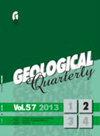Late Pleistocene malacofauna of (MIS-2–MIS-4) loess-palaeosol sequence in Zalesie near Przemyśl (southern Poland)
IF 0.7
4区 地球科学
Q3 GEOLOGY
引用次数: 0
Abstract
Lithological and malacological analysis was carried out at the loess site in Zalesie near Przemyśl. The profile exposed here comprises a loess-palaeosol sequence L-1 and is correlated with the Pleniglacial (MIS-2–MIS-4) of the Weichselian glaciation. Three loess layers separated by interstadial palaeosols are recognised here. Within the two younger parts of the cover, corresponding to the younger middle loess (LMs) and the younger upper loess (LMg), and in the soil horizon (Gi/LMs) separating them, numerous mollusc shells were found. The diversity of the malacofauna allowed five types of faunal assemblages to be distinguished. The main faunal components in the younger middle loess were open-country species typical of the dry subarctic steppe. The interstadial palaeosol horizon developed on this loess was dominated by hygrophilous taxa characteristic of the subarctic tundra environment. The malacofauna of the youngest part of the loess bed (LMg) contained mainly mesophilous snails, indicating the presence of open but relatively humid biotopes. The profile in Zalesie belongs to a tiny group of loess sites in Poland with a complete malacological sequence preserved, covering both the younger upper and middle loesses and the palaeosol horizon separating them.普热米希尔(波兰南部)附近 Zalesie(MIS-2-MIS-4)黄土-古沉积物序列中的晚更新世苹果动物群
在 Przemyśl 附近的 Zalesie 黄土遗址进行了岩石学和苹果学分析。这里出露的剖面包括黄土-古沉积物序列 L-1,与魏希塞尔冰期的次冰期(MIS-2-MIS-4)相关。这里有三个黄土层,被间歇期古溶胶隔开。在覆盖层较年轻的两个部分,即较年轻的中层黄土(LMs)和较年轻的上层黄土(LMg),以及分隔它们的土壤层(Gi/LMs)中,发现了大量软体动物贝壳。根据孔雀石动物的多样性,可以区分出五种动物组合。较年轻的中层黄土中的主要动物成分是典型的亚北极干旱草原的开阔地物种。在这一黄土层上形成的层间古沉积层主要是亚北极苔原环境特有的亲水类群。黄土层最年轻部分(LMg)的蜗牛类群主要为中亲水性蜗牛,表明当时存在开放但相对潮湿的生物群落。Zalesie 的剖面属于波兰黄土遗址中保存有完整孔雀石序列的一小部分,涵盖了较年轻的上黄土和中黄土以及分隔它们的古沉积层。
本文章由计算机程序翻译,如有差异,请以英文原文为准。
求助全文
约1分钟内获得全文
求助全文
来源期刊

Geological Quarterly
地学-地质学
CiteScore
2.20
自引率
0.00%
发文量
19
审稿时长
>12 weeks
期刊介绍:
The policy of the Geological Quarterly is to publish significant contributions of information and geological insight relevant to an international readership. The journal has been issued since 1957 at the Polish Geological Institute - National Research Institute and, at present, is the leading Earth sciences journal in Poland. All aspects of Earth and related sciences, and universal and broad regional rather than locally oriented topics are covered.
The journal is intended to be an international forum for the exchange of information and ideas, particularly on important geological topics of Central Europe.
 求助内容:
求助内容: 应助结果提醒方式:
应助结果提醒方式:


